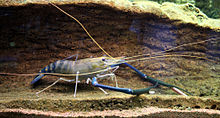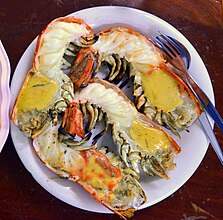Macrobrachium rosenbergii
| Macrobrachium rosenbergii | |
|---|---|
 | |
Conservation status | |
 Least Concern (IUCN 3.1)[1] | |
| Scientific classification | |
| Domain: | Eukaryota |
| Kingdom: | Animalia |
| Phylum: | Arthropoda |
| Class: | Malacostraca |
| Order: | Decapoda |
| Suborder: | Pleocyemata |
| Infraorder: | Caridea |
| Family: | Palaemonidae |
| Genus: | Macrobrachium |
| Species: | M. rosenbergii |
| Binomial name | |
| Macrobrachium rosenbergii De Man, 1879 | |
Macrobrachium rosenbergii, also known as the giant river prawn or giant freshwater prawn, is a commercially important species of palaemonid freshwater prawn. It is found throughout the tropical and subtropical areas of the Indo-Pacific region, from India to Southeast Asia and Northern Australia.[2] The giant freshwater prawn has also been introduced to parts of Africa, Thailand, China, Japan, New Zealand, the Americas, and the Caribbean.[3] It is one of the biggest freshwater prawns in the world, and is widely cultivated in several countries for food.[2] While M. rosenbergii is considered a freshwater species, the larval stage of the animal depends on brackish water.[4] Once the individual shrimp has grown beyond the planktonic stage and becomes a juvenile, it lives entirely in fresh water.[4]
It is also known as the Malaysian prawn, freshwater scampi (India), or cherabin (Australia). Locally, it is known as golda chingri (Bengali: গলদা চিংড়ি) in Bangladesh and India, udang galah in Indonesia and Malaysia, uwáng or uláng in the Philippines, Thailand prawn in Southern China and Taiwan (Chinese: Tàiguó xiā 泰國蝦),[5] and koong mae nam (กุ้งแม่น้ำ) or koong ghram gram (กุ้งก้ามกราม) in Thailand.[3]
Description

M. rosenbergii can grow to a length over 30 cm (12 in).[6] They are predominantly brownish in colour, but can vary. Smaller individuals may be greenish and display faint vertical stripes. The rostrum is very prominent and contains 11 to 14 dorsal teeth and 8 to 11 ventral teeth. The first pair of walking legs (pereiopods) is elongated and very thin, ending in delicate claws (chelipeds), which are used as feeding appendages. The second pair of walking legs are much larger and powerful, especially in males. The movable claws of the second pair of walking legs are distinctively covered in dense bristles (setae) that give them a velvety appearance. The colour of the claws in males varies according to their social dominance.[2][3]
Females can be distinguished from males by their wider abdomens and smaller second pereiopods. The genital openings are found on the body segments containing the fifth pereiopods and the third pereiopods in males and females, respectively.[2][3] However, Prof. Amir Sagi and his research group from the Ben-Gurion University of the Negev have found the IAG physiological sexual switch,[7][8][9][10][11] and its associated gene expression[12][13] in decapods investigating multigenic functions in crustacean reproduction and growth and the establishment of genome editing in prawns using application of CRISPR.[13][14][15][16]
His group established monosex biotechnologies in crustacean culture including the application of temporal RNA interference (RNAi) in the field of aquaculture for all-male culture.[17][9][18][19] Crustacean monosex technologies are applied in Vietnam, Thailand, China, Malaysia, Israel.[20][21][22][23] He is a co-founder of the all-female culture biotech company Enzootic Ltd.[24]
Prawns are efficient predators thus might serve as sustainable and responsible biocontrol agents over various invasive and pest species.[25][9] The Sagi lab development of monosex prawn biotechnologies enables the application of responsible, efficient, and non-invasive biocontrol agents in various parts of the world.[26][22]
Morphotypes
Three different morphotypes of males exist.[27] The first stage is called "small male" (SM); this smallest stage has short, nearly translucent claws. If conditions allow, small males grow and metamorphose into "orange claws" (OC), which have large orange claws on their second chelipeds, which may have a length of 0.8 to 1.4 times their body size.[27] OC males later may transform into the third and final stage, the "blue claw" (BC) males. These have blue claws, and their second chelipeds may become twice as long as their bodies.[4][27]
Males of M. rosenbergii have a strict hierarchy; the territorial BC males dominate the OCs, which in turn dominate the SMs.[27] The presence of BC males inhibits the growth of SMs and delays the metamorphosis of OCs into BCs; an OC keeps growing until it is larger than the largest BC male in its neighbourhood before transforming.[27] All three male stages are sexually active, and females that have undergone their premating moult cooperate with any male to reproduce. BC males protect the females until their shells have hardened; OCs and SMs show no such behaviour.[27]
Life cycle
In mating, the male deposits spermatophores on the underside of the female's thorax, between the walking legs. The female then extrudes eggs, which pass through the spermatophores. The female carries the fertilised eggs with her until they hatch; the time may vary, but is generally less than 3 weeks. Females lay 10,000–50,000 eggs up to five times per year.[4]
From these eggs hatch zoeae, the first larval stage of crustaceans. They go through several larval stages in brackish water before metamorphosing into postlarvae, at which stage they are 0.28–0.39 in (7.1–9.9 mm) long and resemble adults.[4] This metamorphosis usually takes place about 32 to 35 days after hatching.[4] These postlarvae then migrate back into fresh water.
Uses
M. rosenbergii are commonly used in indoor shrimping venues.[13][7]
References
- ^ De Grave, S.; Shy, J.; Wowor, D.; Page, T. (2013). "Macrobrachium rosenbergii". IUCN Red List of Threatened Species. 2013: e.T197873A2503520. doi:10.2305/IUCN.UK.2013-1.RLTS.T197873A2503520.en. Retrieved 19 November 2021.
- ^ a b c d H. Motoh & K. Kuronuma (1980). Field guide for the edible crustacea of the Philippines. Southeast Asian Fisheries Development Center (SEAFDEC). p. 44. Archived from the original on 1 December 2017. Retrieved 23 December 2016.
- ^ a b c d "Macrobrachium rosenbergii (giant freshwater prawn)". CABI. Archived from the original on 23 December 2016. Retrieved 23 December 2016.
- ^ a b c d e f Forrest Wynne (May 2000). "Grow-out culture of freshwater prawns in Kentucky". Archived from the original on 21 August 2008. Retrieved 4 July 2005.
- ^ "(In Chinese) 大陸南方養蝦發展動態概述". www.miobuffer.com.tw. Retrieved 6 January 2024.
- ^ T. Y. Chan (1998). "Shrimps and Prawns". In Kent E. Carpenter; Volker H. Niem (eds.). The Living Marine Resources of the Western Central Pacific. Volume 2: Cephalopods, Crustaceans, Holothurians and Sharks (PDF). FAO Species Identification Guide for Fishery Purposes. Food and Agriculture Organization. ISBN 92-5-104051-6.
- ^ a b 陳, 韋聿 (10 April 2018). "很蝦的歷史:臺灣的釣蝦場是怎麼冒出來的?".
- ^ Ardavan Farhadi et al., 2021. The Regulatory Mechanism of Sexual Development in Decapod Crustaceans. Frontiers in Marine Science, 8, pp. 1-19 (references in pages 13-18; Citations within the text).
- ^ a b c Kenji Toyota, 2024. Crustacean endocrinology: Sexual differentiation and potential application for aquaculture. General and Comparative Endocrinology, Vol. 356, 15 September 2024, 114578.
- ^ "Israeli Innovation Awarded 1st place in the Aquaculture Innovation Award". IsraelAgri.
- ^ Sánchez Keighley, Paul. "Israeli Innovation Awarded 1st. Place in the Aquaculture Innovation Award". IsraelAgri.
- ^ ZHOU Huan et al., 2024. Protein Interaction of IAG in Cherax Quadricarinatus Based on Nuclear Systaem Yeast Two-Hybrid Technology. Acta Hydrobiologica Sinica, 48, pp. 1095-1101 (references 2 & 14).
- ^ a b c Miao M. CRISPR/Cas9-Mediated Gene Mutation of EcIAG Leads to Sex Reversal in the Male Ridgetail White Prawn Exopalaemon Carinicauda. Front Endocrinol (Lousanne), 21 November 2023 (references: 1, 17, 20, 22, 24 & 52). Cite error: The named reference ":0" was defined multiple times with different content (see the help page).
- ^ Grossman, Ariel. "New Project Enhances Crustacean Genes For Sustainable Seafood". No Camels - Israeli Innovation News, November 01, 2023.
- ^ "Targeted Gene Technology Comes to Crustacea Aquaculture". The Fish Site, 1 November 2023.
- ^ "Alliance to Establish Crustacean Gene Editing Technology". Hatchery Feed & Management, Alliance to Establish Crustacean Gene Editing Technology, November 1, 2023.
- ^ Tao Wang et al., Molecular Mechanisms of Sex Determination and Differentiation in Decapod Crustaceans for Potential Aquaculture Applications: An overview. Reviews in Aquaculture, 23 May 2024 (references: 4, 5, 11, 26, 50, 62, 64, 180, 231, 238 & also in the recomanded articles at the 1st page.).
- ^ "It's a Girl! Gene Silencing Technology Alters Sex of Prawns - Peer-Reviewed Publication - Society for Experimental Biology". Eurek Alert, 30-Jun-2014.
- ^ "Transformed Male Prawns Could Increase World Food Supply". Voice of America, by YouTube, 26 October, 2015.
- ^ Phansawat, P., Keetanon, A., Rairat, T., Pichitkul, P., Poldetch, P., & Chuchird, N., 2022. Benefits of Male Monosex Culture of Giant Freshwater Prawn (Macrobrachium rosenbergii): Improving Growth Performance, Production Yield, and Profitability. Journal of Fisheries and Environment, 46, pp.157-168.
- ^ "Biotechnology to boost Malaysian freshwater prawn seed production". Hatchery Feed Management, July 22, 2022.
- ^ a b Vorsanger, Sarah. "Israeli Scientists Use Prawns to Fight Tropical Disease". Zavit - Science Environment in Israel, October 27, 2019.
- ^ "Generating Single-Sex Prawn Populations". World Fishing & Aquaculture, 02/07/2014.
- ^ "Enzootic Team". Enzootic - All-female Shrimp Aquaculture, 26.3.2023.
- ^ Yingying Wang et al., Efficacy of Giant River Prawn Macrobrachium rosenbergii in Controlling the Invasive Snail Pomacea canaliculata: Implications for Ecological Farming. Diversity, 15, September 2023, pp. 1-12 (references: 42, 57 and also 2 recomanded articles).
- ^ Hoover et al., 2019. Modelled effects of prawn aquaculture on poverty alleviation and schistosomiasis control. Nature Sustainability 2: 611-620.
- ^ a b c d e f A. Barki; I. Karplus & M. Goren (1991). "Morphotype related dominance hierarchies in males of Macrobrachium rosenbergii (Crustacea, Palaemonidae)". Behaviour. 117 (3/4): 145–160. doi:10.1163/156853991x00508. JSTOR 4534936.
External links
- How to Know Gender of Macrobrachium rosenbergii.
- Macrobrachium rosenbergii diet.
- Prove Macrobrachium rosenbergii can upsize in wild.
- How to catch Macrobrachium rosenbergii.
- FAO Fisheries & Aquaculture: Macrobrachium rosenbergii - 2021
- Aquaculture of Texas
 Media related to Macrobrachium rosenbergii at Wikimedia Commons
Media related to Macrobrachium rosenbergii at Wikimedia Commons
- v
- t
- e
prawns
(incl. slipper
& spiny)
- American lobster
- Arctides guineensis
- California spiny lobster
- Homarus gammarus
- Ibacus peronii
- Japanese spiny lobster
- Jasus
- Jasus edwardsii
- Jasus lalandii
- Metanephrops challengeri
- Thenus orientalis
- Nephrops norvegicus
- Palinurus elephas
- Panulirus argus
- Panulirus cygnus
- Panulirus echinatus
- Panulirus guttatus
- Panulirus homarus
- Panulirus longipes
- Panulirus ornatus
- Panulirus pascuensis
- Panulirus penicillatus
- Panulirus versicolor
- Parribacus japonicus
- Sagmariasus
- Scyllarides herklotsii
- Scyllarides latus
- Scyllarus arctus
- Thymops birsteini
- Tristan rock lobster
- Callinectes sapidus
- Callinectes similis
- Cancer irroratus
- Cancer bellianus
- Cancer pagurus
- Cancer productus
- Chaceon fenneri
- Chaceon quinquedens
- Chinese mitten crab
- Chionoecetes
- Declawing of crabs
- Dungeness crab
- Florida stone crab
- Gecarcinus ruricola
- Horsehair crab
- Hypothalassia acerba
- Jonah crab
- Maja squinado
- Menippe adina
- Orithyia sinica
- Ovalipes australiensis
- Pie crust crab
- Portunus pelagicus
- Portunus trituberculatus
- Ranina ranina
- Scylla paramamosain
- Scylla serrata
- Soft-shell crab










